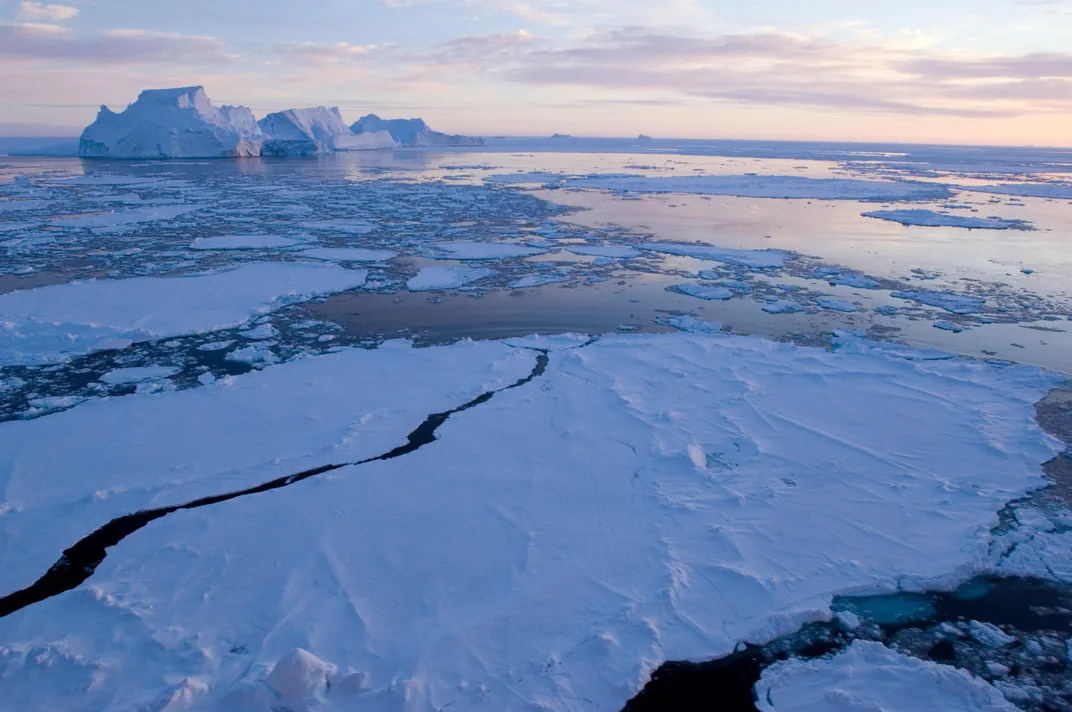The Hidden Underbelly of West Antarctica Is Melting
Warm currents are flowing under ice shelves, causing coastal losses that may let land-based glaciers slide into the sea
/https://tf-cmsv2-smithsonianmag-media.s3.amazonaws.com/filer/b9/1f/b91f4b8e-4b65-4947-8e4a-e2e95ccf2227/42-51653576.jpg)
The ice that lines West Antarctica’s shores is melting at an alarming rate, and the culprit is not hotter air but a one-two punch of warmer deep-water flows and winds that drive them beneath the ice shelves.
The Amundsen and Bellingshausen seas have warmed about 1°F over the past 30 years, researchers report today in Science. “This may not sound like much, but it is a significant difference [when] talking about melting of ice,” says lead author Sunke Schmidtko, a physical oceanographer at the University of East Anglia. “Like at home, if you put ice cubes in a pool that is 34°F or in a pool that is 33°F, the cubes in the pool at 34°F melt significantly faster.”
The loss of ice shelves floating along the continent’s shores is probably detrimental to some sea life, but it doesn’t have an immediate impact on sea level. After all, when ice cubes melt in a glass of water, the volume in the glass doesn't change, and the liquid level remains the same. But the ice shelves hold back the huge ice sheets that sit on the Antarctic continent. When that land-based ice melts and ends up in the ocean, it does result in sea level rise, just as if you added more ice cubes to your glass.
Antarctica holds enough land-based ice that sea level would increase by 200 feet if it all melted. While that is not going to happen anytime soon, West Antarctica alone holds enough ice to trigger a 15- to 16-foot increase in sea level, and researchers have documented the ice sheets there melting at a quick pace. For example, scientists reported earlier this week in Geophysical Research Letters that glaciers sitting on land near the Amundsen Sea have tripled their rate of loss in the last 10 years. They’re losing volumes of water at a rate equal to the weight of Mount Everest every two years.

Scientists had suspected that ocean warming was behind such ice loss, but this has been difficult to confirm because of the inaccessibility of water sitting beneath hundreds of feet of floating ice. To get around that problem, Schmidtko and colleagues looked at 40 years of publicly available data from past oceanographic research cruises and floating instruments, which describe the temperature and salinity of water flowing into those regions.
From that data, they could see warming in a large current called the Circumpolar Deep Water, which flows onto the Antarctic continental shelf at depths of around 1,000 feet. Around most of Antarctica, winds keep the Circumpolar Deep Water from getting close enough to the ice shelves to cause melting. But in the Amundsen and Bellingshausen seas, the winds are different, and they are driving the warming water under the ice shelves.
That melting trend will probably continue for the near future, Schmidtko says. “The consequences would be that the glaciers in West Antarctica will keep accelerating, [and] will further increase their discharge of ice and freshwater into the ocean. This consecutively causes an accelerated increase of the part of sea level rise that is due to Antarctica.”
But the bigger worry may be in the Weddell Sea, the researchers note. So far, cold temperatures there have prevented any large-scale melting, but warm water masses are rising up. “If the shoaling of warm water masses continues, it is expected that there will be major environmental changes with dramatic consequences” for nearby ice shelves, Schmidtko says. “For the first time, glaciers outside the West Antarctic could experience enhanced melting from below.”
Currently, winds appear to be sheltering the Weddell and Ross seas from the Circumpolar Deep Water melting, notes Sarah Gille of the Scripps Institution of Oceanography in an article accompanying the Science study. However, she warns, “future changes in the winds could modify that, and thus alter the ice-shelf buttresses, with further effects on global sea level rise.” That could be very bad news for the millions of people living along the world’s shorelines.
/https://tf-cmsv2-smithsonianmag-media.s3.amazonaws.com/accounts/headshot/Sarah-Zielinski-240.jpg)
/https://tf-cmsv2-smithsonianmag-media.s3.amazonaws.com/accounts/headshot/Sarah-Zielinski-240.jpg)